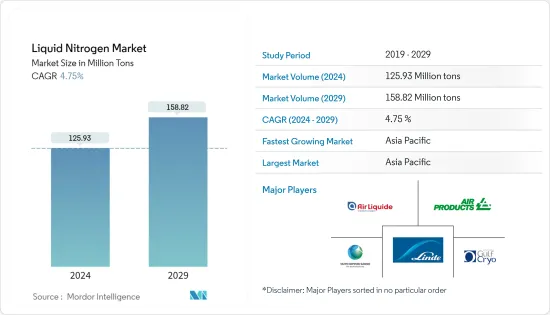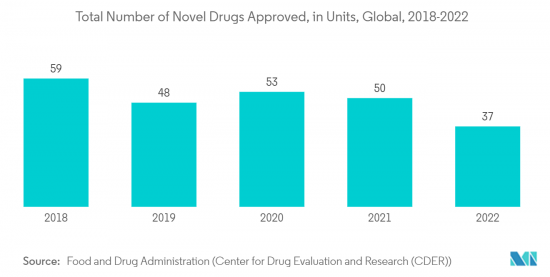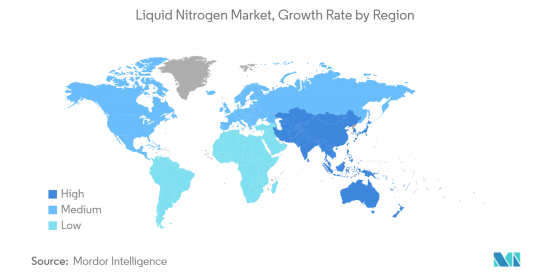 |
市場調查報告書
商品編碼
1430576
液態氮:市場佔有率分析、產業趨勢與統計、成長預測(2024-2029)Liquid Nitrogen - Market Share Analysis, Industry Trends & Statistics, Growth Forecasts (2024 - 2029) |
||||||
※ 本網頁內容可能與最新版本有所差異。詳細情況請與我們聯繫。
液態氮市場規模預估2024年為1,2,593萬噸,預估2029年將達1,5,882萬噸,在預測期內(2024-2029年)年複合成長率為4.75%,預計會成長。

COVID-19 阻礙了市場成長。由於全球限制,運輸業遭受了疫情的影響。然而,由於大流行,由於健康問題的增加,醫療保健行業出現了顯著成長。隨著醫療設備需求大幅增加,液態氮市場需求也隨之增加。目前,市場已經從疫情中恢復過來,並正在經歷顯著成長。
主要亮點
- 從中期來看,化學和製藥行業需求的增加以及醫療保健行業應用的擴大正在推動市場成長。
- 然而,維護液態氮工廠存在監管限制,預計將阻礙市場成長。
- 也就是說,新製造技術的開拓可能會在未來幾年為市場創造機會。
- 亞太地區主導全球市場,消費量最高的國家為中國、印度和日本。
液態氮市場趨勢
化學和製藥業的需求不斷增加
- 液態氮是元素氮的液化形式,透過液態空氣分餾在商業性生產。用於許多冷卻和低溫應用。
- 它惰性、無味、無色、化學惰性、易燃,廣泛應用於化學和製藥工業。
- 氮氣的沸點為攝氏-195度。因此,其在化學和製藥行業中作為冷卻劑和冷媒的用途正在迅速擴大。
- 中國的製藥業是世界上最大的製藥業之一。該國生產學名藥、治療藥物、原料藥和草藥。
- 根據中國國家統計局統計,2022年6月,中國原料藥月產量突破30萬噸。這一數字在過去三年中逐漸成長,反映了中國化學品業務的發展。活性藥物成分是在疾病治療中發揮作用的藥物化學物質。
- 此外,根據藥品管理局的數據,印度是世界上最大的學名藥供應商,截至 2022 年 2 月,其藥品供應量超過 220 億美元。從數量來看,印度藥品佔全球學名藥出口量的20%,其中北美佔大部分。預計到2030年將達到1,000億美元左右,未來幾年該市場的潛力將持續增加。
- 其最大的優點之一是氮氣是一種乾燥的惰性氣體。這意味著它不與其他物質相互作用。結果,氧氣和其他有毒或不必要的氣體,特別是氧氣,可以用氮氣代替。
- 在製造藥品時,氮氣經常用於將反應混合物從一個容器轉移到另一個容器。運輸液體或粉末藥品時,使用安全的惰性氣體極為重要。某些藥物化學物質在暴露於氧氣或水蒸氣時可能有害或爆炸。
- 根據食品藥物管理局(藥品審查與研究中心(CDER))統計,2022 年批准了 37 個新藥。每年上市的新藥數量波動很大。 2021年,50個獨特藥物獲得核准。
- 由於上述所有因素,預計化學和製藥業對液態氮的需求在預測期內將會成長。

亞太地區主導市場
- 預計亞太地區將在預測期內主導液態氮市場。中國、印度和日本等國家化學和製藥行業的成長正在推動該地區液態氮市場的需求。
- 根據《中國醫藥健康報告》,2023年,中國醫藥和生物製藥的研發投入合計預計將以每年平均23%的速度成長。如果達到 490 億美元,佔全球藥物開發和測試支出的 23%,這是可能的。
- 該國擁有龐大且多元化的國內製藥業,由大約 5,000 家製造商組成,其中許多是中小企業。預計將支持製藥行業液態氮使用的成長。
- 國家藥品監督管理局聯合公佈《醫藥工業「十四五」發展規劃》。 「十四五」規劃明確了未來五年我國醫藥工業發展的目標與方向。
- 「十四五」規劃是依照《國家經濟和社會發展「十四五」規劃和2035年中長期目標綱要》提出的思路和標準制定的。
- 印度化學工業預計將強勁成長。政府預測,到 2025 年,化學工業將達到 3,040 億美元,這提供了機遇,因為未來五年需求預計將以每年 9% 左右的速度成長。
- 根據綜合冷鏈和加值基礎設施計劃,到2022年,印度已核准約356個食品加工行業低溫運輸計劃,這將增加對液態氮的需求。
- 亞太地區的主要液態氮製造商包括 Linde PLC、Southern Industrial Gas Sdn Bhd、MVS Engineering Pvt. Ltd 和 Taiyo Nippon Sanso Corporation。
- 因此,預計上述因素將在預測期內推動該地區液態氮市場的需求。

液態氮產業概況
液態氮市場碎片化。該市場的主要企業包括液化空氣公司、空氣化工產品公司、Gulf Cryo、Linde PLC 和 Taiyo Nippon Sanso。
其他福利:
- Excel 格式的市場預測 (ME) 表
- 3 個月分析師支持
目錄
第1章 簡介
- 調查先決條件
- 調查範圍
第2章調查方法
第3章執行摘要
第4章市場動態
- 促進因素
- 化學和製藥業的需求增加
- 擴大在醫療保健產業的應用
- 其他司機
- 抑制因素
- 維護液態氮工廠的監管限制
- 其他阻礙因素
- 產業價值鏈分析
- 波特五力分析
- 供應商的議價能力
- 買方議價能力
- 新進入者的威脅
- 替代品的威脅
- 競爭程度
第5章市場區隔(市場規模,基於數量)
- 儲存類型
- 圓柱
- 包裝氣體
- 功能
- 冷卻劑
- 冷媒
- 最終用戶產業
- 化學/製藥
- 衛生保健
- 運輸
- 其他最終用戶產業
- 地區
- 亞太地區
- 中國
- 印度
- 日本
- 韓國
- 其他亞太地區
- 北美洲
- 美國
- 加拿大
- 墨西哥
- 歐洲
- 德國
- 英國
- 義大利
- 法國
- 歐洲其他地區
- 南美洲
- 巴西
- 阿根廷
- 南美洲其他地區
- 中東/非洲
- 沙烏地阿拉伯
- 南非
- 其他中東/非洲
- 亞太地區
第6章 競爭形勢
- 併購、合資、聯盟、協議
- 市場佔有率分析(%)**/排名分析
- 主要企業策略
- 公司簡介
- Air Liquide
- Air Products and Chemicals, Inc.
- Cryomech Inc.
- Gulf Cryo
- Linde plc
- MVS Engineering Pvt. Ltd
- Southern Industrial Gas Sdn Bhd
- Praxair Technology, Inc.
- Messer Group
- TAIYO NIPPON SANSO CORPORATION
第7章 市場機會及未來趨勢
- 新製造技術開發
- 其他機會
The Liquid Nitrogen Market size is estimated at 125.93 Million tons in 2024, and is expected to reach 158.82 Million tons by 2029, growing at a CAGR of 4.75% during the forecast period (2024-2029).

COVID-19 hampered the market growth. The transportation industry suffered from the pandemic due to restrictions worldwide. However, due to the pandemic, the healthcare industry witnessed huge growth because of increased health concerns. It increased the demand for the liquid nitrogen market, as the demand for medical devices increased tremendously. Currently, the market recovered from the pandemic and is growing at a significant rate.
Key Highlights
- Over the medium term, the increasing demand from the chemical and pharmaceutical industry and the growing application in the healthcare industry are driving market growth.
- However, the regulatory restrictions in maintaining liquid nitrogen plants are expected to hinder the market's growth.
- Nevertheless, developing new manufacturing techniques will likely create opportunities for the market in the coming years.
- The Asia-Pacific region dominated the global market with the largest consumption from countries such as China, India, and Japan.
Liquid Nitrogen Market Trends
Growing Demand from the Chemical and Pharmaceutical Industry
- Liquid nitrogen is the liquefied form of the element nitrogen produced commercially by the fractional distillation of liquid air. It is used in many cooling and cryogenic applications.
- Owing to its non-toxic, odorless, colorless, chemically inert, and inflammable properties, its application is highly used in the chemical and pharmaceutical industry.
- The boiling point of nitrogen is -195 degrees Celsius. Because of this, its application as a coolant and refrigerant in the chemical and pharmaceutical industry is rapidly increasing.
- The pharmaceutical industry in China is one of the largest in the world. The country produces generics, therapeutic medicines, active pharmaceutical ingredients, and traditional Chinese medicine.
- According to the National Bureau of Statistics of China, in June 2022, China's monthly output volume of chemical active pharmaceutical ingredients (API) topped 300,000 metric tonnes. The figure gradually climbed over the previous three years, indicating a development in China's chemical medication business. Active pharmaceutical ingredients are medicinal chemicals responsible for a condition's therapy.
- Moreover, according to the Department of Pharmaceuticals, India is the world's largest supplier of generic medications, and as of February 2022, the country supplied pharmaceuticals worth more than USD 22 billion. Regarding volume, Indian pharmaceuticals accounted for 20% of worldwide generic drug exports, with North America accounting for the lion's share. It is expected to value about USD 100 billion by 2030, increasing the scope for this market during the coming years.
- The fact that nitrogen is a dry, inert gas is one of its greatest advantages. It implies that it won't interact with other substances. As a result, oxygen and other toxic or unwanted gases, particularly oxygen, can be replaced by N2.
- Nitrogen is frequently used to manufacture pharmaceuticals to transfer the reaction mixture from one container to another. When delivering liquid or powdered medications, it is crucial to employ safe, inert gas since doing so might be hazardous. Several pharmaceutical chemicals may be harmed or even explode if exposed to oxygen or water vapor.
- According to the Food and Drug Administration (Center for Drug Evaluation and Research (CDER)), it authorized 37 new medications in 2022. The amount of new pharmaceutical products hitting the market each year fluctuates greatly. In 2021, there were 50 approvals for unique medications.
- Owing to all the factors mentioned above, the demand for liquid nitrogen is expected to grow from the chemical and pharmaceutical industries during the forecast period.

Asia-Pacific Region to Dominate the Market
- The Asia-Pacific region is expected to dominate the market for liquid nitrogen during the forecast period. The growing chemical and pharmaceutical industries in countries such as China, India, and Japan are boosting the demand for the liquid nitrogen market in the region.
- According to China's Healthcare Report, China's pharmaceutical and biopharmaceutical combined R&D investment is projected to expand at a compound annual rate of 23% through 2023. It will be possible when it reaches USD 49 billion, accounting for 23% of global drug development and testing spending.
- The country includes a large and diverse domestic drug industry, comprising around 5,000 manufacturers, of which many are small- or medium-sized companies. It is expected to boost the growth of liquid nitrogen usage in the pharmaceutical industry.
- The National Medical Products Administration and the National Administration of Traditional Chinese Medicine collaborated to release the "14th Five-Year Plan for Pharmaceutical Industry Growth." The 14th Five-Year Plan specifies the aims and directions for China's pharmaceutical industry's development during the following five years.
- The 14th Five-Year Plan was developed in compliance with the ideas and standards outlined in the Framework of the 14th Five-Year Plan for National Economic and Social Development and Long-Term Goals for 2035.
- India is expected to witness robust growth in its chemical industry. The government predicts the chemical industry to reach USD 304 billion by 2025, with opportunities offered by the anticipated increase in demand by about 9% per annum over the next five years.
- According to the Scheme of Integrated Cold Chain and Value Addition Infrastructure, about 356 Cold Chain Projects in the food processing industry were approved in India in 2022, creating an increasing demand for liquid nitrogen.
- Some leading producers of liquid nitrogen in the Asia-Pacific region include Linde PLC, Southern Industrial Gas Sdn Bhd, MVS Engineering Pvt. Ltd, and TAIYO NIPPON SANSO CORPORATION.
- Therefore, the factors above are expected to boost the demand for the liquid nitrogen market in the region during the forecast period.

Liquid Nitrogen Industry Overview
The liquid nitrogen market is fragmented in nature. Some of the major players in the market include Air Liquide, Air Products and Chemicals, Inc., Gulf Cryo, Linde plc, and TAIYO NIPPON SANSO CORPORATION, among others.
Additional Benefits:
- The market estimate (ME) sheet in Excel format
- 3 months of analyst support
TABLE OF CONTENTS
1 INTRODUCTION
- 1.1 Study Assumptions
- 1.2 Scope of the Study
2 RESEARCH METHODOLOGY
3 EXECUTIVE SUMMARY
4 MARKET DYNAMICS
- 4.1 Drivers
- 4.1.1 Increasing Demand from the Chemical and Pharmaceutical Industry
- 4.1.2 Growing Application in the Healthcare Industry
- 4.1.3 Other Drivers
- 4.2 Restraints
- 4.2.1 Regulatory Restrictions in Maintaining Liquid Nitrogen Plant
- 4.2.2 Other Restraints
- 4.3 Industry Value Chain Analysis
- 4.4 Porter's Five Forces Analysis
- 4.4.1 Bargaining Power of Suppliers
- 4.4.2 Bargaining Power of Buyers
- 4.4.3 Threat of New Entrants
- 4.4.4 Threat of Substitute Products and Services
- 4.4.5 Degree of Competition
5 MARKET SEGMENTATION (Market Size in Volume)
- 5.1 Storage Type
- 5.1.1 Cylinder
- 5.1.2 Packaged Gas
- 5.2 Function
- 5.2.1 Coolant
- 5.2.2 Refrigerant
- 5.3 End-user Industry
- 5.3.1 Chemical and Pharmaceutical
- 5.3.2 Healthcare
- 5.3.3 Transportation
- 5.3.4 Other End-user Industries
- 5.4 Geography
- 5.4.1 Asia-Pacific
- 5.4.1.1 China
- 5.4.1.2 India
- 5.4.1.3 Japan
- 5.4.1.4 South Korea
- 5.4.1.5 Rest of Asia-Pacific
- 5.4.2 North America
- 5.4.2.1 United States
- 5.4.2.2 Canada
- 5.4.2.3 Mexico
- 5.4.3 Europe
- 5.4.3.1 Germany
- 5.4.3.2 United Kingdom
- 5.4.3.3 Italy
- 5.4.3.4 France
- 5.4.3.5 Rest of Europe
- 5.4.4 South America
- 5.4.4.1 Brazil
- 5.4.4.2 Argentina
- 5.4.4.3 Rest of South America
- 5.4.5 Middle-East and Africa
- 5.4.5.1 Saudi Arabia
- 5.4.5.2 South Africa
- 5.4.5.3 Rest of Middle-East and Africa
- 5.4.1 Asia-Pacific
6 COMPETITIVE LANDSCAPE
- 6.1 Mergers and Acquisitions, Joint Ventures, Collaborations, and Agreements
- 6.2 Market Share Analysis (%) **/Ranking Analysis
- 6.3 Strategies Adopted by Leading Players
- 6.4 Company Profiles
- 6.4.1 Air Liquide
- 6.4.2 Air Products and Chemicals, Inc.
- 6.4.3 Cryomech Inc.
- 6.4.4 Gulf Cryo
- 6.4.5 Linde plc
- 6.4.6 MVS Engineering Pvt. Ltd
- 6.4.7 Southern Industrial Gas Sdn Bhd
- 6.4.8 Praxair Technology, Inc.
- 6.4.9 Messer Group
- 6.4.10 TAIYO NIPPON SANSO CORPORATION
7 MARKET OPPORTUNITIES AND FUTURE TRENDS
- 7.1 Development of New Manufacturing Techniques
- 7.2 Other Opportunities













